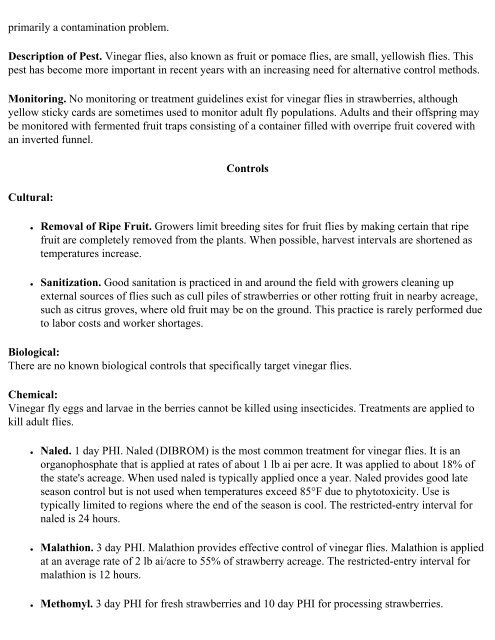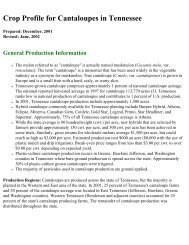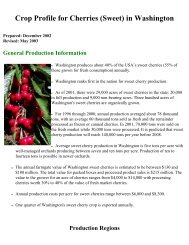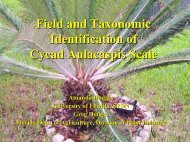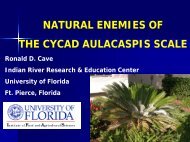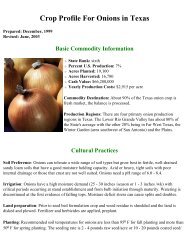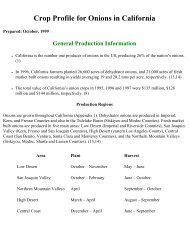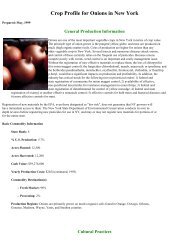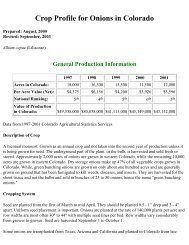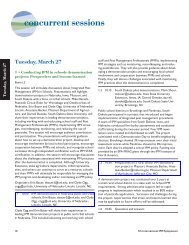Crop Profile for Strawberries in California - Regional IPM Centers
Crop Profile for Strawberries in California - Regional IPM Centers
Crop Profile for Strawberries in California - Regional IPM Centers
You also want an ePaper? Increase the reach of your titles
YUMPU automatically turns print PDFs into web optimized ePapers that Google loves.
primarily a contam<strong>in</strong>ation problem.<br />
Description of Pest. V<strong>in</strong>egar flies, also known as fruit or pomace flies, are small, yellowish flies. This<br />
pest has become more important <strong>in</strong> recent years with an <strong>in</strong>creas<strong>in</strong>g need <strong>for</strong> alternative control methods.<br />
Monitor<strong>in</strong>g. No monitor<strong>in</strong>g or treatment guidel<strong>in</strong>es exist <strong>for</strong> v<strong>in</strong>egar flies <strong>in</strong> strawberries, although<br />
yellow sticky cards are sometimes used to monitor adult fly populations. Adults and their offspr<strong>in</strong>g may<br />
be monitored with fermented fruit traps consist<strong>in</strong>g of a conta<strong>in</strong>er filled with overripe fruit covered with<br />
an <strong>in</strong>verted funnel.<br />
Cultural:<br />
Controls<br />
● Removal of Ripe Fruit. Growers limit breed<strong>in</strong>g sites <strong>for</strong> fruit flies by mak<strong>in</strong>g certa<strong>in</strong> that ripe<br />
fruit are completely removed from the plants. When possible, harvest <strong>in</strong>tervals are shortened as<br />
temperatures <strong>in</strong>crease.<br />
● Sanitization. Good sanitation is practiced <strong>in</strong> and around the field with growers clean<strong>in</strong>g up<br />
external sources of flies such as cull piles of strawberries or other rott<strong>in</strong>g fruit <strong>in</strong> nearby acreage,<br />
such as citrus groves, where old fruit may be on the ground. This practice is rarely per<strong>for</strong>med due<br />
to labor costs and worker shortages.<br />
Biological:<br />
There are no known biological controls that specifically target v<strong>in</strong>egar flies.<br />
Chemical:<br />
V<strong>in</strong>egar fly eggs and larvae <strong>in</strong> the berries cannot be killed us<strong>in</strong>g <strong>in</strong>secticides. Treatments are applied to<br />
kill adult flies.<br />
● Naled. 1 day PHI. Naled (DIBROM) is the most common treatment <strong>for</strong> v<strong>in</strong>egar flies. It is an<br />
organophosphate that is applied at rates of about 1 lb ai per acre. It was applied to about 18% of<br />
the state's acreage. When used naled is typically applied once a year. Naled provides good late<br />
season control but is not used when temperatures exceed 85°F due to phytotoxicity. Use is<br />
typically limited to regions where the end of the season is cool. The restricted-entry <strong>in</strong>terval <strong>for</strong><br />
naled is 24 hours.<br />
● Malathion. 3 day PHI. Malathion provides effective control of v<strong>in</strong>egar flies. Malathion is applied<br />
at an average rate of 2 lb ai/acre to 55% of strawberry acreage. The restricted-entry <strong>in</strong>terval <strong>for</strong><br />
malathion is 12 hours.<br />
● Methomyl. 3 day PHI <strong>for</strong> fresh strawberries and 10 day PHI <strong>for</strong> process<strong>in</strong>g strawberries.


